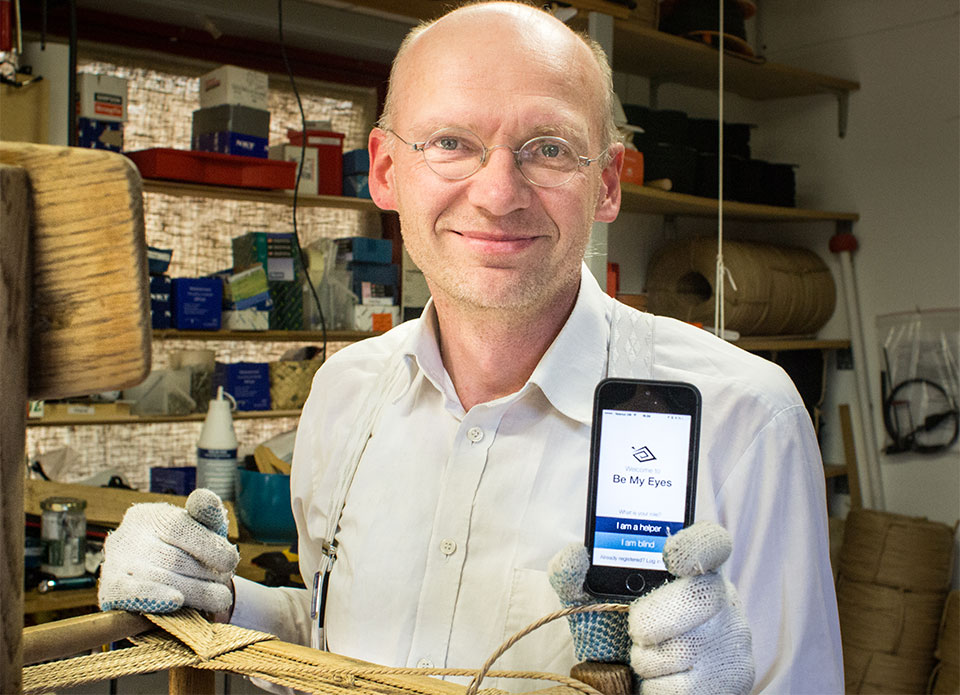- OT
- Science and vision
- Technology
- Pocket perfection: how technology is transforming the lives of those with sight loss
Pocket perfection: how technology is transforming the lives of those with sight loss
“For the last 20 years, I have had to wait for my husband to wake up to read me the newspaper. Now, as soon as he wakes up, I tell him about it”
02 January 2019
Many people would not think twice about checking the oven is at the right temperature or making sure that a shirt and tie do not clash. But these everyday scenarios can prove challenging for people living with sight loss.
This is where Danish entrepreneur Hans Jorgen Wiberg had a light bulb moment.
Mr Wiberg, who has retinitis pigmentosa, wondered what would happen if he enabled blind and partially sighted people to “borrow” the eyes of sighted volunteers for short amounts of time using smartphone technology.
“I didn’t see this solution anywhere, so I thought, ‘I will have to make it myself’,” he told OT.
The resulting Be My Eyes technology turns on a smartphone’s camera, microphone and speaker to link a user with sighted volunteers who help with simple tasks such as checking the expiry date on a milk carton.
Following its launch three years ago, more than 104,000 blind and partially sighted people have signed up to use Be My Eyes, alongside 1.8 million volunteers around the globe who speak 180 different languages. Of these volunteers, 84,000 are based in the UK.
Mr Wiberg explained that the beauty of the technology is that it provides an anonymous, hassle-free way to ask for help with simple things.
“It is not about building a relationship with the other person; it is just about asking the question, ‘Can I borrow your eyes for 30 seconds?” he said.
For volunteers, signing up to Be My Eyes is an easy way of giving back to the community, Mr Wiberg added.

Working together
Be My Eyes has certainly proved to be a low-key way of volunteering for Andrew Hodgson.
After signing up to be a volunteer two years ago, he has only received one call from a man attending a formal dinner party.
“He asked ‘Which of these two shirts is more formal?’ then he hung up,” Mr Hodgson told OT.
Mr Hodgson is the chief technology officer for In Your Pocket, a voice-controlled mobile reading device and smartphone designed specifically for people with vision impairment.
The device launched in the UK in March 2018. It has a simple interface that does not require users to touch the screen or enter a password.
Mr Hodgson shared that when In Your Pocket was first launched in Australia, a woman called him up and told him that the device had changed her life.
“I asked her, ‘How?’ and she said, ‘For the last 20 years, I have had to wait for my husband to wake up and read me the newspaper. Now, as soon as he wakes up, I tell him about it,” Mr Hodgson recounted.
Mr Wiberg added that while this might seem like a small thing, it is invaluable.
“Suddenly you, as a low vision or blind person, can add something: you are not always the person receiving or asking for advice,” he shared.
“You can make dinner or tell your husband the news. It is hugely important for your life,” he observed.
In December, In Your Pocket announced the integration of Be My Eyes.
Mr Wiberg highlighted that the development would mean people who required more technical support to get started with Be My Eyes would be able to access the technology.
“I hope we can reach a larger group of people,” he said.
In Your Pocket user experience: Roger Wilson-Hinds
Advertisement



Comments (0)
You must be logged in to join the discussion. Log in